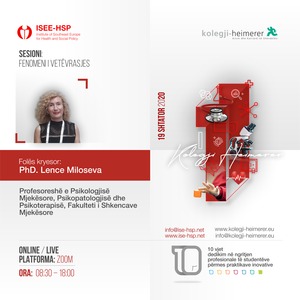Miloseva, Lence (2020) Passive suicidal ideation as a clinical relevant marker for suicide. In: Keynote speech, 11th International Health Science Symposium of Heimerer College, 19 Sept 2020, Virtual event.
ABSTRACT-Prof. Miloseva 19 Sept. 2020.pdf
Download (54kB) | Preview
Program 11 th International Symposium of Health Sciences.pdf
Download (165kB) | Preview
![Key Note.png [thumbnail of Key Note.png]](https://eprints.ugd.edu.mk/27570/3.hassmallThumbnailVersion/Key%20Note.png)

Key Note.png
Download (618kB) | Preview
Abstract
This lecture provides a brief overview of the importance of risk and protective factors as they relate to suicide and offers guidance about how mental health experts and communities can best use them to decrease suicide risk. Special emphasis was placed on the role of passive suicidal ideation as a risk factor for suicide. Also, we discussed difficulties during screening and suicide risk assessment processes. In recent years, researchers and clinicians do not treat passive suicidal ideation as a clinically relevant risk factor for suicide, while underestimating the strength of this desire to die, compared with making a plan for suicide in individuals having active suicidal ideation. Screening of clinically relevant risk factors for suicide and identifying specific differences between passive and active suicidal ideation allow clinicians to identify the group of individuals at risk of suicide, to offer appropriate prevention and effective treatment. There are empirical findings that are in favor of that passive suicidal ideation, or the "wish to die" is also an important factor to consider in assessing the risk of suicide (Baca-Garcia et al., 2011; Moran, 2013). Passive suicidal ideation can be characterized as emotionally colored thoughts, more as a wish, according to which life is not worth living or that it is better for the person to be dead (Schulberg et al., 2005; Raue et al., 2007; Moran, 2013). Unfortunately, both in the region and in North Macedonia there are no general studies that examine passive suicidal ideation or compare the role and importance of passive and suicidal ideas, i.e. how they contribute to suicidal risk and suicidal behavior, which is why this topic is a research challenge. Empirical findings and experiences from the world and North Macedonia were presented and discussed. A combination of a desire for death and suicidal ideation is the best predictor for suicide attempts. This is of high clinical relevance since we suggest that desire for death should be included as a potential clinical marker of suicidality in clinical assessments.
Keywords: clinically relevant; marker; passive suicidal ideation; active suicidal ideation; suicidal risk
| Item Type: | Conference or Workshop Item (Keynote) |
|---|---|
| Subjects: | Medical and Health Sciences > Clinical medicine |
| Divisions: | Faculty of Medical Science |
| Depositing User: | Lence Miloseva |
| Date Deposited: | 05 Feb 2021 09:48 |
| Last Modified: | 05 Feb 2021 09:48 |
| URI: | https://eprints.ugd.edu.mk/id/eprint/27570 |
